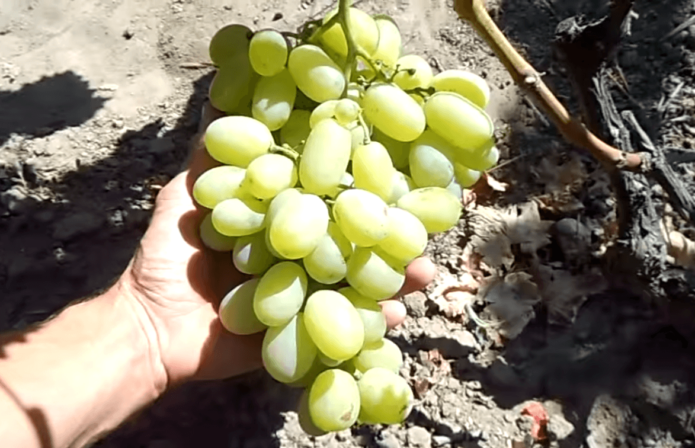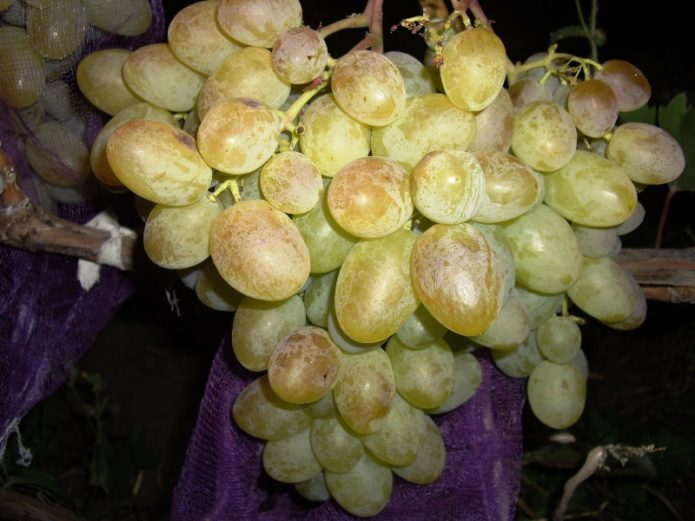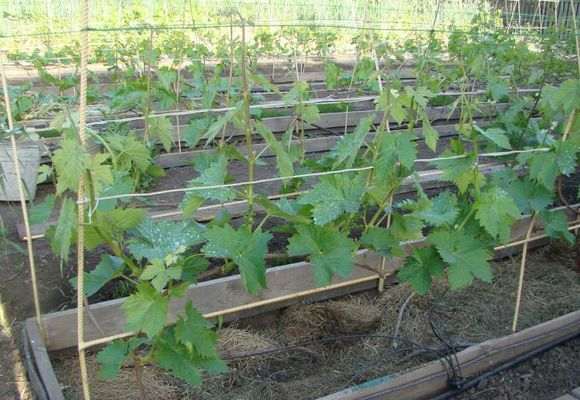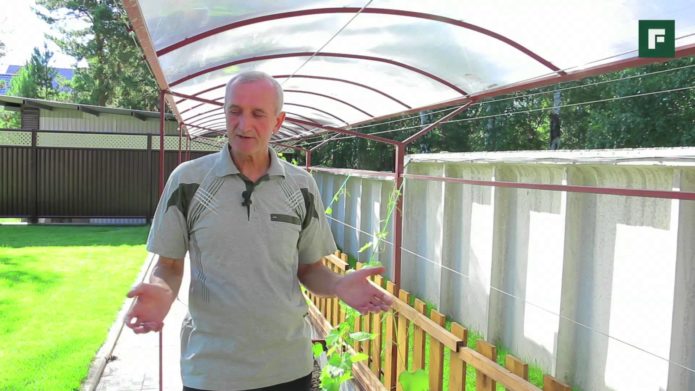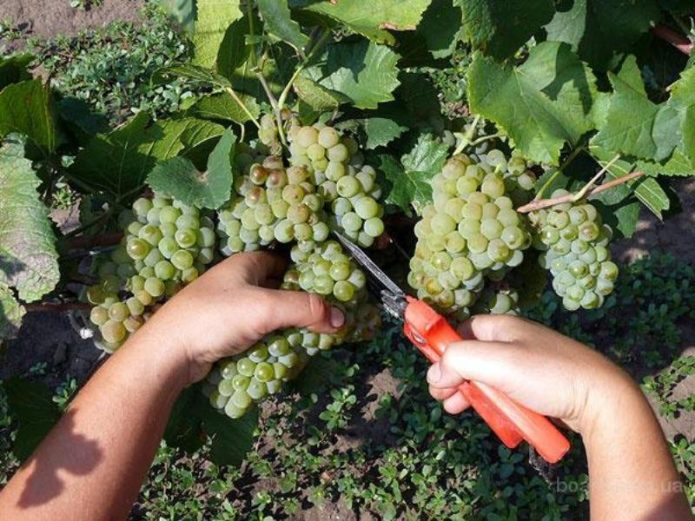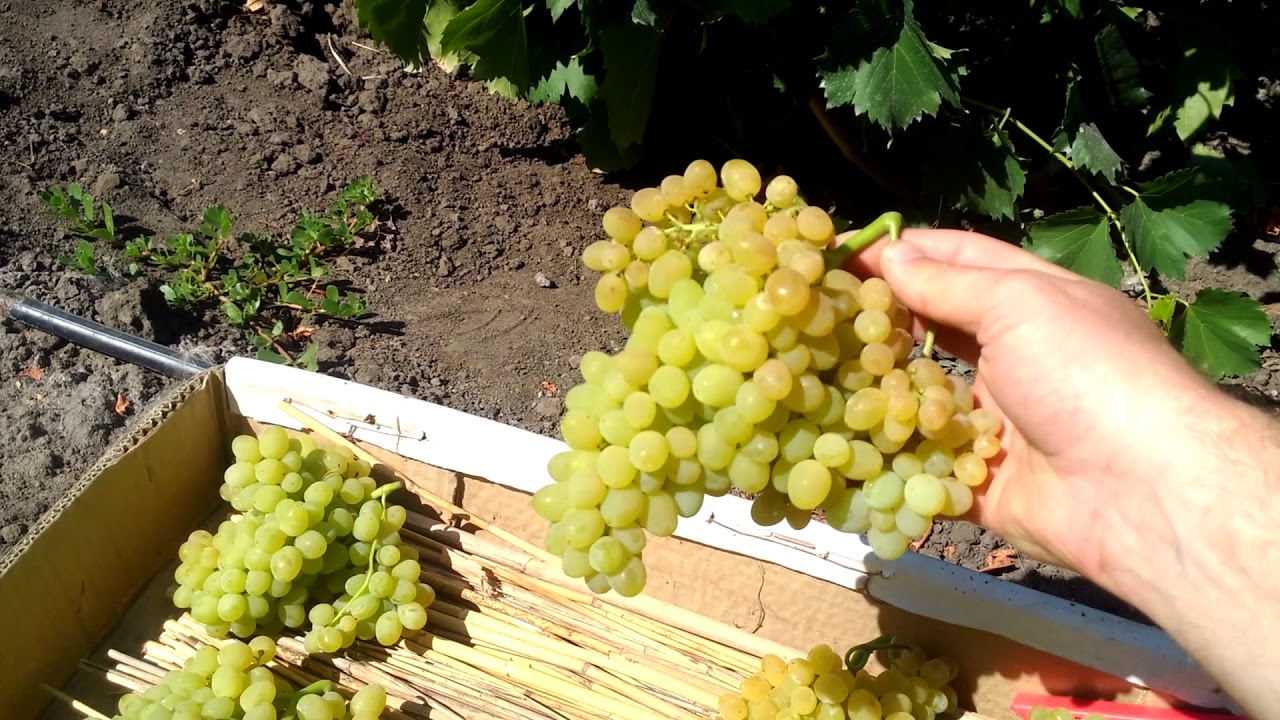Gardeners who have been dealing with grapes for several years know about such a famous amateur breeder as Viktor Nikolaevich Krainov. They know and grow the hybrid forms created by him. Many varieties from the so-called Krainov's three have settled on the plots: Victor, Anniversary of Novocherkassk and Transfiguration. At one time, NiZina became a legend. Bogatyanovsky grapes were also created by this talented creator. And you really need to be a very sophisticated winegrower to find flaws in this hybrid form. Very insignificant, but they, nevertheless, are, however, they can be easily adjusted when growing.
Content
The history of growing grapes Bogatyanovsky
An application for registration of this hybrid form was received by the State Commission of the Russian Federation for Testing and Protection of Breeding Achievements in 2013. The applicant and originator is the All-Russian Research Institute of Viticulture and Winemaking named after V. Potapenko, located in Novocherkassk. The variety was entered into the State Register two years later, in 2015. However, Bogatyanovsky was created and spread to amateur gardens much earlier. On the forums, you can find reviews and controversies about this grape, dated 2007. The exact date of the appearance of the variety is unknown. But there is an interview with its author, V.N.Krainov, in which he says that he received his first hybrid forms in the period 1998-2004, and by 2009 there were already 45.

Breeders Krainov V.N., Voronyuk I.N., Nevzorov V.V. at the annual exhibition of achievements of winegrowers in Novocherkassk
Krainov is an amateur winegrower without any academic titles. He developed new varieties on his garden plot in Novocherkassk, on the banks of the Tuzlov River. In the same place, as a result of cross-pollination of grapes Kishmish radiant and Talisman, seedlings were obtained, from which the national breeder isolated the hybrid form Bogotyanovsky.
In the State Register and on some sites dedicated to viticulture, including the works of Krainov, the variety is written through the letter "o", that is, Bogotyanovsky. However, in most of the Internet space, including numerous forums of winegrowers, the spelling with the letter "a" was fixed.
Today this variety is actively used by modern breeders to create new forms. In February 2010, its creator passed away. Topics “VN Krainov died” appeared on the forums of winegrowers, in which condolences and gratitude for his work were expressed. Krainov varieties are grown in orchards and vineyards in Russia, Ukraine, Belarus, Kazakhstan. So the hybrid form Bogatyanovsky has remained with us and will delight its owners for many years to come and cause enduring disputes about its advantages and disadvantages.
Main characteristics of the variety
Video: about the features of Bogatyanovsky grapes
Bogatyanovsky is a large-fruited white table grape. Its berries are round-oval in shape and reach a diameter of 4 cm, and weighing 12-18 g. Bunches can grow up to 2.2 kg. However, in the State Register, more modest sizes are indicated and in practice are often observed: berries up to 12 g, bunch weight - 400-800 g. Much depends on the method of formation, the load of the bush, weather conditions, the presence of fertilizing and other factors. The large run-up between the minimum and maximum indicators suggests that there is a lot of potential hidden in Bogatyanovsky, and it is worth looking for an approach to this variety.
Bunches are ready to harvest 125-135 days after bud break. In the conditions of the homeland of the variety, Novocherkassk, where the climate is characterized by excess heat and lack of moisture, Bogatyanovskiy ripens at the end of August, and in the conditions of Luhansk (eastern Ukraine), with relatively early spring and frequent return frosts, in mid-September.
Ripe berries acquire a yellow tint, and in the sun - a brown tan. The pulp is gristly, without tastes and aromas. Bunches do not lose their presentation for a long time, they tolerate transportation well. Bogatyanovsky is grown for themselves and for sale. Buyers are attracted and surprised by the large size of the berries, so there are no problems with implementation.
Own-rooted bush vigorous, occupies about 6 m² on a plot. Each shoot is fruitful, on some of them two clusters are tied. Productivity in skilled hands and in a favorable climate - 35 kg. Disease resistance is average, without preventive treatments it can get sick with mildew and powdery mildew. Bogatyanovsky is afraid of frosts below -23 ⁰C, therefore, he is not grown on gazebos in an uncovered form, even in the south.
Planting seedlings
The variety is unpretentious in its care, all classical techniques for grapes are applicable to it, including planting. Only the arrangement of seedlings can be called individual: 2 m in a row and 3 m between rows. The size of the planting pit depends on the soil structure. On poor, clayey and sandy ones, it should be large - 80x80 cm to 1 m, on black soil less - 50x50 cm. Drainage to the bottom is laid only on clay soil that does not absorb water well, on all others, especially on sandy ones, it does not linger at the roots anyway.
Video: planting grapes
Fill the pit by a third with organic matter (humus, manure, compost, kitchen waste, grass, etc.), add 40 g of superphosphate and 25 g of potassium sulfate to each bush. On top of such a pillow, lay a layer of soil from the site (5–7 cm) so that the roots do not touch the fertilizers. You can plant grapes in the prepared hole.
Bogatyanovsky is laid on the ground in the fall, so deepen the seedling to the first branch on the trunk. Then the vines will be easier to bend. You can tilt to the side where you plan to lay them. In the year of planting, the growing shoots can be tied to high stakes, but by the next season, build a strong trellis.

Bury the seedlings of Bogatyanovsky to the green side shoot, the vine that has grown from it over the summer will be easier to lay on the ground
Bogatyanovsky grape care
Watering for this variety is standard - once a month, but plentiful - 5-6 buckets under a fruiting bush. But this is an approximate norm, take into account the weather and soil moisture. When watering, you should soak the soil to a depth of 80–90 cm for the bulk of the roots. Vineyard care will be greatly facilitated: drip irrigation and mulch with a layer of at least 6-7 cm.
Stop watering when the berries reach their size. During the ripening period, you can build a protection from rain, for example, install a canopy or cover the ground under the bushes with roofing felt or slate with a slope from the bush. Excessive moisture during this period can lead to watery fruits, the concentration of sugars in them will decrease.
In the fall, before laying the vines on the ground, do water-charging watering. In spring, it will give vines the strength to bud and grow leaves. If in the fall the ground is already damp from rains, of course, there is no need to water.
Like any grape, Bogatyanovsky will be more generous in the harvest if he receives additional feeding. On loamy and sandy loam soils, medium in fertility, it is enough to feed three times:
- In early spring, apply nitrogen fertilizer: urea, ammonium nitrate (1 tablespoon per 10 liters of water) or organic matter (infusions of mullein, droppings, weeds).
- Before flowering, you need dressing containing trace elements. These are sold in stores. Choose special ones for grapes or fruit and berry crops under well-known brands: Fertika, Clean sheet, Agricola, etc.
- In the fall, after harvesting, make grooves 15 cm deep around or along the bushes. Spread 1.5 tbsp. Evenly over them. l. superphosphate and the same amount of potassium sulfate per plant. Water the grooves and level. Scatter 1–2 buckets of humus under each bush and mix with the topsoil.
On poor clay and sandy soils in the spring, make two nitrogen fertilizers at intervals of 2 weeks. And on chernozems, humus should be applied not every autumn, but once every 3-4 years.
Video: fertilizers for grapes
Formation and rationing of the crop deserves special attention. Winegrowers are always interested in how the bush will react to a particular number of shoots and bunches on them. General recommendations for Bogatyanovsky are as follows:
- the number of eyes on the bush - 30–35;
- leave shoots - 20-22;
- cut vines into 8-10 buds.
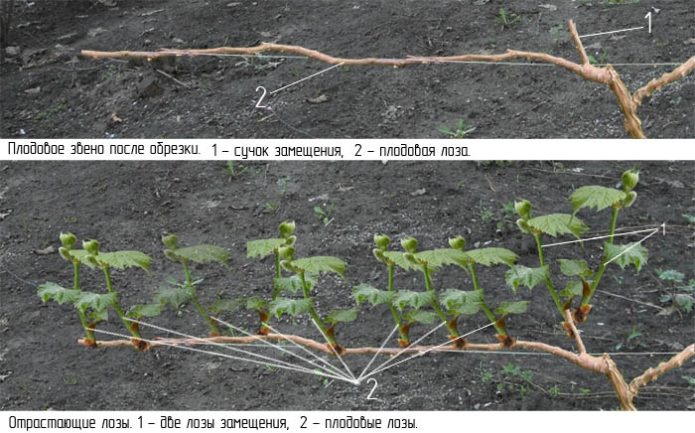
Shown is one of the grape sleeves (fruit link); green shoots growing vertically upward are fruitful, they will have clusters
However, different areas and each climatic zone have their own nuances. If the summer is favorable, you can load the bush harder, leaving 2 clusters for the shoot. However, the fewer the bunches, the larger and faster they ripen. Consider the warnings of the growers that Bogatyanovsky's berries are baked in the heat, damaged bunches do not grow or ripen. That is, you will lose that part of the crop that fell under the scorching rays. Therefore, shade the brushes that are not covered with leaves, for example, by hanging rags of gauze over them.
Video: Bogatyanovsky's clusters are covered with rags of white fabric
For the prevention of diseases, be sure to do two fungicide treatments at the beginning of the season. They have proven themselves well: HOM, Topaz, Bordeaux liquid, Skor, Ridomil, Arcerid. Change the preparations, for example, spray the first time with Skor, after 10-14 days with Ridomil. As for the method of shelter, it, like much in care, depends on the climate in your region, namely: what kind of winters are:
- frosty and snowy - just lay the vines on the ground, the snow will serve as a shelter;
- frosty and little snow - cover with reed mats, burlap, straw, spruce branches, sprinkle with earth;
- frosts alternate with thaws and rains - cover the vines, as in the previous version, and build a semblance of a roof made of waterproof material on top.
Collection and appointment of Bogatyanovsky grapes
It is not recommended to overexpose the berries of this variety on the vines. Wasps can partially damage the crop. Harvest grapes for market or storage in the morning, when the dew has dried, but the berries have not yet warmed up in the sun. Cut off the bunches, holding on to the stalks, try not to touch the surface of the fruit again, so as not to damage the wax coating. It protects the skin from fungi and rot development. For local consumption, cut the grapes when and how you like.
Bogatyanovskiy - a variety for table use, contains: sugars - 20%, organic acids - 7-8%. It is mainly consumed fresh. To preserve the bunches until the New Year, they are placed in boxes lined with paper and taken to a room where the temperature is kept within 0… +4 ⁰C. Can be stored suspended, while the clusters should not touch each other.
Advantages and disadvantages of the variety (table)
| Advantages | disadvantages |
| Very large berries | Average ripening period, in some regions it ripens in autumn |
| Decent productivity | Berries lack sweetness and aromas |
| Grows well with standard care | The bunches need to be shaded |
| The flower is bisexual, no other pollinating varieties are needed | Large bones and voids around them |
| Not prone to peas | Cannot be grown uncovered |
| Berries do not crack after rains | Requires preventive spraying for diseases |
| Bears fruit steadily, annually | |
| On each shoot 1-2 bunches are laid, there are no problems with the load of the bush |
Winegrowers reviews
In my opinion, Bogatyanovsky from the region "the prison is strong, but the devil is happy with it." In our conditions, it happens like this: the berries are very large, like those that are not irrigated in the Talisman, rather leveled, but the flesh is very liquid, due to which the skin bulges out, the taste properties are very mediocre, ripens at least a week later than the Talisman, oidium is also affected, winter hardiness is worse than at the Talisman. Berries sometimes have such a rusty tan, like Rapture. Yes, about 12 g or more berries. Under full normal load (not the first fruiting, but the present), the average berry weight is 10.9 g, and the bunches are not very large - 480-550 g, while they were not larger, but due to very large berries it looks beautiful. But the taste leaves much to be desired, much better. My opinion is personal.
My berries "Bogatyanovsky" are baked in the sun before ripening, shade. A ripe bunch of sun is not afraid, a light tan appears. And yet, constant watering is needed, otherwise the berry does not gain size, and during ripening it may stick. This variety has a distinctive feature - a rather long comb.
I have two bushes of GF Bogatyanovsky, grown from my own vegetative seedlings. Immediately, I note that the growth force of my own-rooted bushes is average. Probably this GF would be better developed on a vigorous rootstock (who has such experience, share). In the 2012 season. there was the first small harvest. The load was rationed, but the berry ripened late at the end of September, simultaneously with the gf Luchezarny (Krainova). The berry is tasty, although not very sweet.There were no large bunches - there were up to 400-600g (declared up to 2.5kg.), The berries are also medium-sized - maybe the first fruiting. There was no cod of berries, wasps damaged individual berries by the end of ripening. Fungal diseases (three treatments) were not . The leaves were slightly affected by a felt mite (itch). The vine matured to 6–8 buds - probably there was still a slight overload. I am satisfied with the results of the first fruiting, I will look further.
Grape variety Bogatyanovskiy! Very productive, tasty, one might say, stable, market variety with large berries.
Bogatyanovsky grapes are grown according to standard technology, there are no nuances that complicate care. However, at the same time, the berries grow very large, do not crack, taste without frills, but many people like it. Such a variety can become one of the main varieties in a professional vineyard. A beginner can easily find an approach to it.


